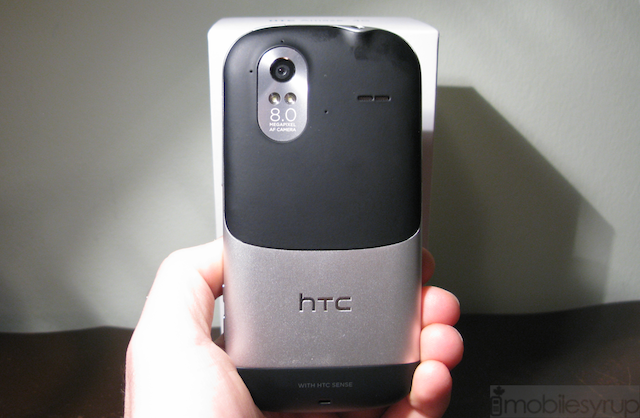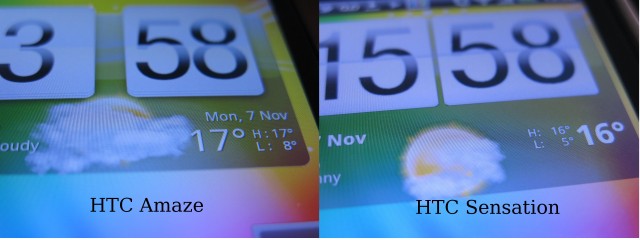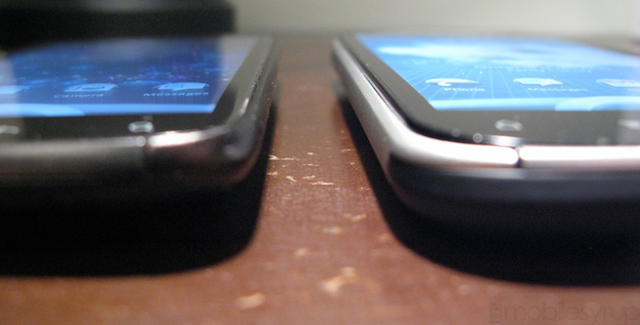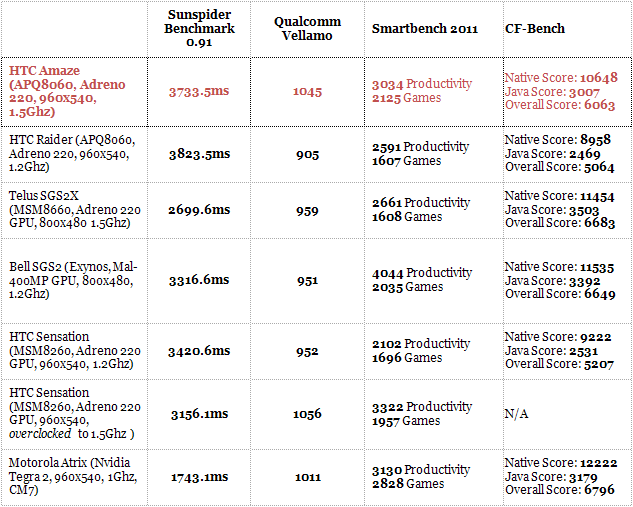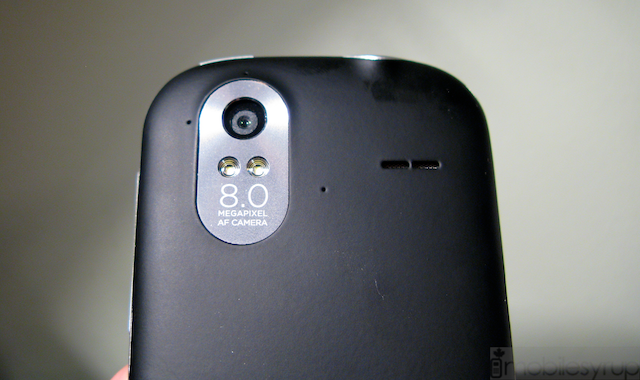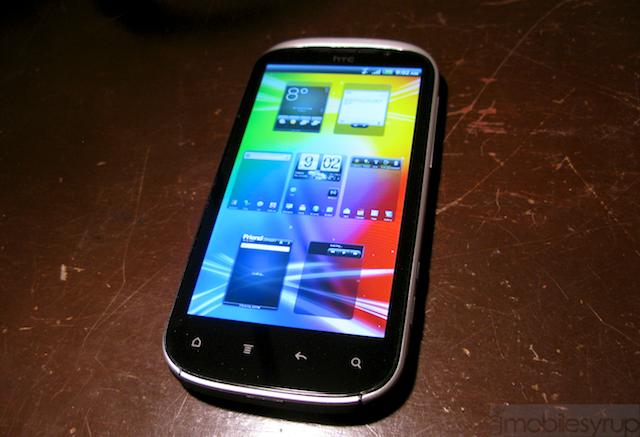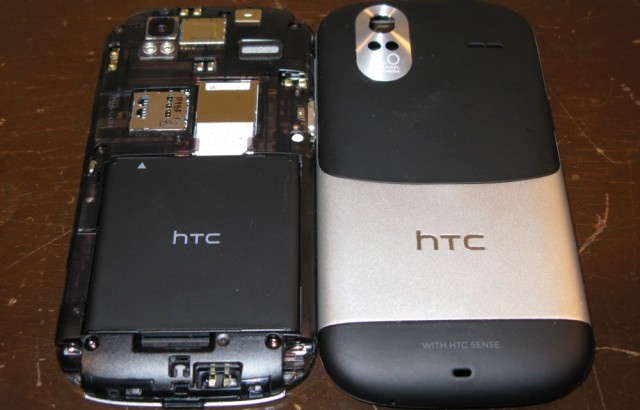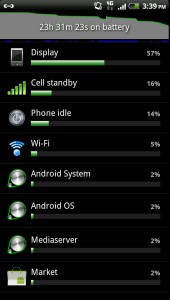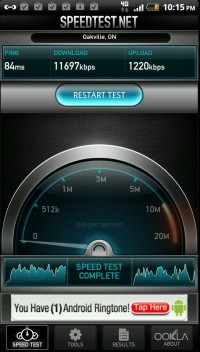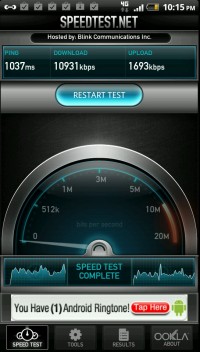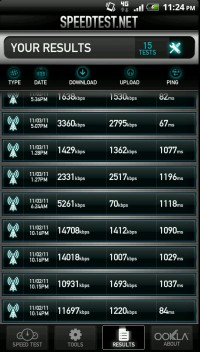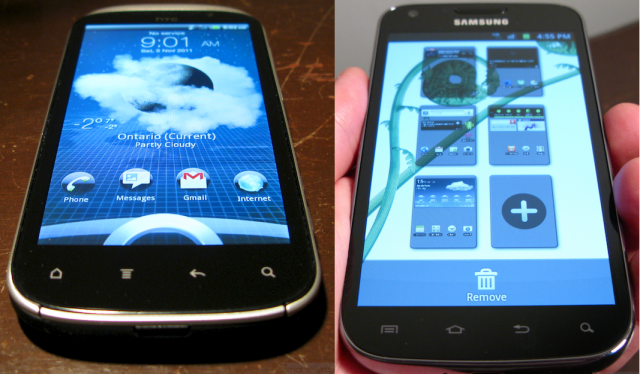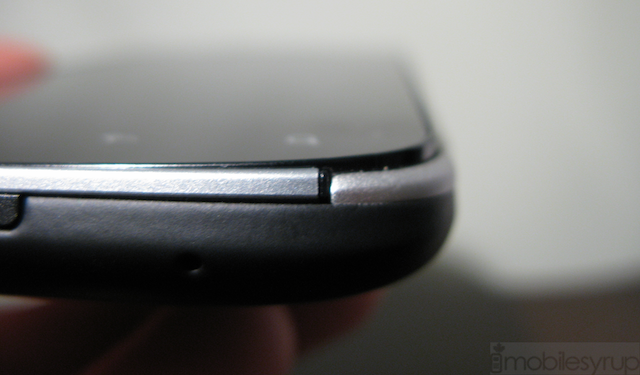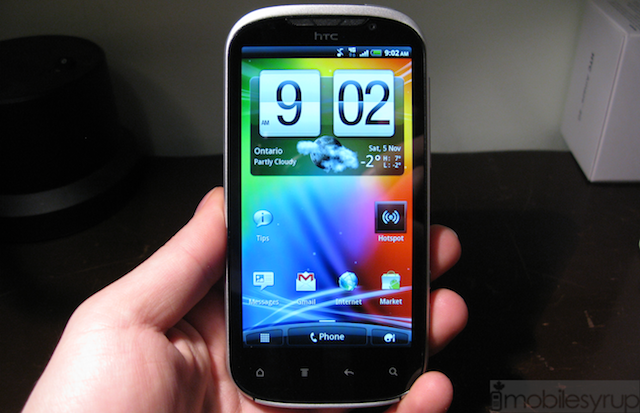
On paper, the HTC Amaze is our dream phone. Rounded and comfortable, dual-toned (silver and black) with a gorgeous 4.3″ qHD display, dedicated camera and camcorder buttons to accent its no-lag 8MP camera, a 1.5Ghz dual-core processor with enough RAM to feed an army. There is definitely a lot to like about the Amaze, which debuts exclusively on Telus (for now).
And since we use a lot of handsets, it is difficult to have an emotional connection with any one of them; you get in, use it for a few days, and get out. Rarely do we come off a review yearning to own one ourselves. And yet that is exactly what happened with the Amaze which is, in our opinion, the best device HTC has made in a very long time. Though it may lack the GPU firepower of Bell’s Galaxy S II or the HD screen of the LG Optimus LTE, it’s shaped right, performs right, and does just about everything we need it to do for as long as we need it to do. Don’t believe us? Read on…
Specs:
– Android 2.3.4 with HTC Sense 3.0
– 4.3 inch 960×540 pixel qHD display
– 1.5Ghz APQ8060 Snapdragon S3 processor w/ Adreno 220 GPU
– 1GB RAM, 16GB internal eMMC storage (expandable to 48GB)
– 8MP camera w/dual LED flash, f/2.2 aperture, 28mm lens with dedicated camera button, 2MP front camera
– 1080p video capture w/ dedicated camcorder button
– Bluetooth 3.0, WiFi b/g/n
– MDM8200T baseband supporting HSPA+ (850/1700/1900/2100MHz) and quad-band GSM/EDGE (850/900/1800/1900MHz)
– 130 x 65.6 x 11.8 mm, 173g
– 1730mAh battery
The Phone
There is no overstating it: the Amaze is a huge phone. It’s thick, at nearly 12mm, heavy at 173g and imposing. There is no mistaking it as either an Android device or an HTC creation. The silver accent appears almost white in the right light, and the earpiece grill is taken straight from the T-Mobile’s myTouch line. In fact, the Amaze is the myTouch 4G Slide combined with the HTC Sensation. It hits all the right points: solid without being rigid, thick without being oversized. It fits perfectly in our hands, and but for the comparatively low pixel density, we preferred using it to the iPhone 4S for most tasks. There is no question that a 4.3″ screen is going to be too big for some, and the perfect compromise for others.
Build quality is excellent, as the aluminum battery cover fits over the device like a glove. Portions of the backing are black matte plastic, owing to the fact that HTC stores the MIMO antennas for cellular connectivity in plain view. These gold overlays, along with an NFC chip, are situated at the top and bottom of the inside piece, allowing for simultaneous transmit and receive while limiting attenuation. And because the Amaze incorporates Dual-Cell HSPA+ technology, there are two dedicated transmit and receive antennas for a maximum throughput of 42Mbps.
The right side of the device incorporates a lengthy volume rocker, of the same silver shade as the rest of the bezel, and two camera buttons: one for the photo app, another for video. While we’re not sold on the need for the smaller camcorder button — it takes one touch from within the app to change to video mode — its inclusion makes recording a 1080p clip a two-second practice. The respective apps can be accessed at any time, even when the phone is off, by holding down either button. Add to that the fact that the shutter is nearly instantaneous and you’ve got one heck of a point-and-shoot replacement.
The bottom houses the latch to open the battery, while the left side owns the microUSB/MHL connector which, when paired with a converter can output what’s on the screen to an HDMI port. While the connector may look proprietary, it’s actually compatible with all microUSB ports. The back of the device is stunning. Multiple microphones pepper the soft black plastic while, on the top left side the wide-angle 8MP camera lens sits like a king above two variable LED flash lights. The speaker to the right emits tinny, disquieting sound and is one of the Amaze’s great flaws (even though sounds is excellent through the headphone port). We love the two-tone style but can’t help but think the aluminum-plated areas feel too plasticky for our liking. Nevertheless the body is extremely hardy.
The Display
Without falling prey to the “not-the-best-so-it-sucks” syndrome, the qHD display on the Amaze is stunning. No, it’s not HD — it’s only 258ppi — but it’s one of the best currently on the market, and a HUGE improvement over the lacklustre screen on the Sensation. Colours are vivid, text is clear, and most importantly, viewing angles are much better, almost 180 degrees. We found, compared to the Raider, the colours are in fact over-saturated, more like a Super AMOLED screen than an LCD. Black levels are improved somewhat over the Raider’s slightly greyish tint and, since the same resolution is on a slightly smaller screen, everything is just that much sharper.
That’s not to say everything is amazing on the Amaze. The LCD glass itself, in a provocative display of showmanship, extends up and past the aluminum bezel, jutting out uncomfortably. As we glide our thumb or forefinger towards the edge of the screen we reach the precipice only to be welcomed by a sharp, discordant railing of sorts. We don’t understand why HTC didn’t just curve the glass concave with the bezel; it would have made for functional and aesthetic uniformity.
Performance
The HTC Amaze, internally, is almost identical to the Samsung Galaxy S II X. Both devices run the 1.5Ghz variant of Qualcomm’s Snapdragon S3 processor, along with 1GB RAM and the MDM8200 baseband. Functionally, since we find TouchWIZ to be a great deal smoother in operation than HTC’s Sense UI, it comes down to which Android skin you prefer more or, ultimately, hate less.
Compared to the Raider, which is clocked 300Mhz slower, the Amaze is the obvious winner. Even scrolling, swiping and typing within the Sense UI itself, or launching apps, rendering web pages or playing 3D games, appear noticeably faster on the Amaze. This should seem self-evident, but at these speeds, when everything seems to run pretty smoothly, even the most subtle of performance improvements is well felt.
Benchmarks, too, speak for themselves. As you can see below, the Amaze outscores the SGS2X by nearly 100 points in Qualcomm’s own Vellamo benchmark, and routs it in Smartbench 2011. Only CF-Bench is left to the Samsung handset, likely due to its hardware-accelerated browsing experience that fares so well in Javascript tests. Neither of them can compete against the Mali-400MP GPU of the Bell Galaxy S II, though the Snapdragon chip bests it in multi-core CPU tests.
We’ve said it before, though: we feel that Sense UI, with its bloated animations and garish graphical flourishes, is becoming more a liability for HTC than a benefit. Its aesthetic has barely changed since its Android launch in 2009 on the HTC Hero, sporting Android 1.5 Cupcake. Though steadily improved, it has reached maturity in Gingerbread like an aging king — more Robert Baratheon than Tywin Lannister — no longer able to fight the battles he once relished. We hope that with Ice Cream Sandwich, HTC lets Google have more of an aesthetic influence, while remaining a leader of Android content and well-designed first-party apps. There is nothing wrong with the company continuing to focus on coherent, quality experiences but the more Sense diverts from the original Android source code, the longer it will be for updates and the more alienated its customers from core experiences.
Cameras
The Amaze incorporates HTC’s now-infamous f/2.2 8MP lens, “the best smartphone camera on the market,” so they claim. Whether marketing hyperbole or fact is irrelevant: the same optics are present on the Raider, the upcoming Windows Phone-powered Titan and, previously the myTouch 4G Slide. There is no doubt the experience is markedly better than its immediate predecessor, the Sensation: flat colours are now vibrant, laborious shutter speeds now instant, blurry subjects now clear. The UI has been polished and simplified, the excess removed, and it is now — we hate to admit it — more Apple-like in its fundamental objective of getting out of the way and allowing the user to take great pictures.
But unlike the iPhone’s interface, HTC has hidden in plain sight numerous excellent one-touch modes and settings. When you first enter the camera app there are four icons vertically arrayed on the right side: Camcorder/Camera; Front-facing camera; Flash; Effects. The bottom icon, a magic wand, brings up a list of effects on the left side: Panorama, HDR, Burst Mode, Vintage, Depth of Field, Dots, Greyscale, Posterize and more. In addition, once shot, the built-in photo editor can add Instagram-type filters for added indie cred. In all seriousness, without any filters or special modes the Amaze takes wonderful still shots. Like all phone cameras it fares less well in low light, and we honestly found it to be less capable than the iPhone 4S or Galaxy S II in this regard, but the f/2.2 sensor is a great deal better than any HTC has previously used. But as you can tell from the park shot below, the edges of photos tend to be significantly softer than the centre, exposing the disadvantages of such a small lens in its ability to focus on a large area.
If there is one area in which the Amaze, and its Raider cousin, betters any device we’ve previously used, is in its shutter speed. Because the device is constantly caching what it sees on the screen to take a photo is all but instantaneous. While multiple shots are sometimes blurry — and the Burst mode mostly useless as a result — it is possible to pre-focus, which automatically adjusts the white balance and depth of field, and not worry your object will be out of range once the shutter goes. Even the iPhone 4S, which claims an instant shutter, often needs to adjust its focus for half a second before shooting. And like its iOS competitor, the Amaze can pre-focus by tapping anywhere on the screen. Though by default the phone reviews each shot for three seconds, by turning this option off you can take hundreds of shots a minute, ensuring at least one perfect moment.
We found the flash to be more capable than the Raider’s, firing accurately and consummately to fill half a room (and not make its subjects white-eyed and pale). Like any good camera flash it fires twice, once to meter the amount of light available to the lens, and to adjust the white balance accordingly, and the second, more severe, to light the object appropriately. It appears to work well most of the time, though it occasionally overcompensates and overexposes subjects in the immediate foreground. With the Amaze’s capable face detection, a setting enabled by default, its IQ managed to adjust exposure, focus and ISO as well as we’ve seen from any phone thus far. And, due to its lower aperture, you can expect a modicum of true depth of field, something missing from last generation’s camera phones.
Like with the Raider, we also found the Amaze’s images to be sharper than the 4S, with truer colours. It must be said that the iPhone, once it gains focus, takes shots faster with less blur than the Amaze, but unless you’re trying to follow a sneaky two year old around the house the difference shouldn’t be perceptible.
The 2MP front-facing camera adorning the Amaze is on par with its Galaxy S II nemesis, and works great with Skype, Google Talk and checking your hair. While clearer than the majority of other front shooters out there, it serves an otherwise limited function.
The Amaze also takes fantastic 1080p video, though like HTC’s other products it doesn’t handle motion very well. What should be a completely flawless 30fps pan across a busy intersection quite bumpy, exposing the inherent problems of small lenses and complex compression. Though we love the quality of the end product — like its stills, the Amaze excels in capturing the most minute details of its subjects — we found compression artifacts in scenes with low light and frame rate drops in stark lighting changes. We experienced the same problem with the Raider (see sample video) but, thankfully, the Amaze handled motion a great deal more adeptly due to its faster processor. It also helps that the chassis is thicker than the Raider’s, and that of the iPhone 4S, allowing one to grasp the device more firmly.
One problem we occasionally ran into was when we held the phone as we would a regular camera — with our thumb and palm supporting the device at the front, with our index finger over the trigger — our palm would brush over the Home button and either exit the app or bring up the multitasking menu. There should be an option to temporarily disable the capacitive buttons while taking photos or shooting video.
Software
The HTC Amaze runs the same version of Android 2.3.4 with Sense 3.0 as the Raider and the Sensation before it. Ultimately it comes down to whether you can stomach Sense over Android, or whether you like Android at all. We like Sense and think that it brings a consistency and fluidity to Android that was sorely needed before the announcement of Ice Cream Sandwich. Since seeing ICS in action, however, we are less bullish on the future of HTC’s skin and its placement in the Android ecosystem. While ultimately an argument for another day, you’re not going to find anything particularly new on the Amaze.
We also found very little to complain about, either. Apps were, for the most part, stable and fast. Our favourite third-party apps such as Twitter for Android, Google Reader, Rdio, Skype — they all operated with aplomb. The reason we included the last two, in addition to being a couple of our most-used programs, is because they are pre-loaded on the Amaze. Telus has entered into a partnership with Rdio and Skype, allowing for carrier billing and, for Rdio, a one-month free trial. Unfortunately they cannot be uninstalled; if you update them through the Marketplace, “uninstalling” them will just remove those updates, not the app itself.
It’s a practice that is becoming increasingly and brazenly common in the industry, and though perhaps we should count ourselves lucky not to have the same amount of bloatware as Verizon or AT&T, two companies notorious for their excess, it’s a sad, cold precedent. It should not take rooting an Android device to be able to remove non-system apps that can be downloaded from the Marketplace. We suppose the argument could be make that Gmail or Google Maps, both pre-loaded, are too available for download and also cannot be removed, but it’s a slippery slope.
Read our Raider review, our Sensation review or our Raider vs Amaze Showdown for more insight into Sense 3.0 and the Android 2.3.4 software.
Battery Life
Before the Amaze launched in Canada it debuted on T-Mobile in the US. Like a bogeyman come out to play, one of the biggest criticisms of the device was over its plainly poor battery life. Some reviewers were complaining of less than 8 hours on a single charge, which should be easily attainable from the 1730mAh battery.
Perhaps it’s because Telus consistently gives the Amaze a stronger signal, reducing 3G signal searching, but we had no such issues with the battery life. No, it’s not great, but we were able to get through an entire day on a single charge, and even a couple times well into the following morning. We liken this to a couple things: the Amaze is bright, even when set to Auto. Lowering it to 1/3 of the max brightness still gave us plenty of lumens to work with without killing the juice.
Second is to keep track of what’s happening in the background. We’re not talking Task Killers here — those are utterly useless since all they do is close open apps, not prevent them from starting again — but rather being vigilant about what is loaded onto your phone in the first place. With no third-party apps loaded, the Amaze easily lasted two days with some phone calls, photos and browsing.
Once we loaded Facebook and Twitter on there, battery life halved. This is a by-product of push notifications and background updates — the former is a scourge to iOS battery life, the latter not possible on it — and needs to be addressed head on. Android inherently necessitates more user interaction with its settings; in fact, it encourages it. Most apps will never perform any background function, but be aware of every app you download and check them for how frequently they access the network behind your back. While the ability to truly multitask can be a fantastic benefit to Android users, it can also be its biggest battery-related liability.
For monitoring of what is going on in the background of your Android device, we recommend downloading System Panel. The Lite version is a free download but we recommend the paid version for real-time monitoring.
Overall, while we weren’t happy with the Amaze’s battery life, with a bit of diligence we managed average-to-good results, and certainly a full day’s use per charge is not out of reach.
Network speeds, sound quality and other benefits
We knew the Amaze held in it some magic, and we were surprised to find a couple bonuses, too. The MDM8200T baseband chipset inside the device supports not only Telus’ 850/1900Mhz HSPA+ channels, but the AWS frequencies used by WIND Mobile and Mobilicity. This is advertised right on the box. While the device obviously comes locked to Telus, it’s not too far a stretch to see the Amaze arriving at one of these new entrants in the next few months. At the moment it is T-Mobile’s flagship device, and would be a huge benefit to either company.
While we’re on the subject of speed, we may want to mention the Amaze supports up to 42Mbps in the downlink. This is a theoretical maximum, though we averaged around 7-10Mbps down and 2-4Mbps up. Compared to the Raider, whose LTE speeds often topped 25Mbps, the Amaze is disappointing. Compared, however, to the iPhone 4S, which maxes out at 14.4Mbps down, and it consistently hit double the speed or higher.
For many users across Canada who don’t and will not have access to LTE for many more months the Amaze may be the fastest device available to them.
As for voice quality, we had consistently excellent sound, in part due to the multiple noise-cancelling microphones adorned on the device’s battery cover. Speaker quality, while thin and tinny, fared better than any HTC device we’ve used so far. We played M83’s Midnight Children through its speaker and got some room-filling volume; whether it will fill the room with joy is debatable.
Headset sound reached equally head-destroying heights, and though the Amaze does not come with HTC’s new Beats equalizer settings its clean DAC and ample amplifier had no trouble powering our 120-ohm Beyerdynamic headphones.
Another nice inclusion in the Amaze is NFC connectivity. While not as widely advertised as on the Galaxy S II X (we came across it by accident) it’s a useful feature to have as more vendors include NFC payment systems and more developers add quick transfer features to their apps.
This or the Galaxy S II X?
A lot of people have an opinion one way or the other. Both devices are virtually identical internally. They share the same processor, GPU, amount of RAM, internal storage and megapixels. The SGS2X has a 4.5″ 800×480 Super AMOLED Plus display with perfect blacks and vivid colour; the Amaze has a 4.3″ 960×540 Super LCD display with more accurate colours, higher brightness and sharper text. It’s also more solidly constructed but much heavier than the Samsung.
Both have incredible cameras capable of replacing a point-and-shoot. Neither of them will replace your video camera just yet. We prefer the lightweight nature of TouchWIZ 4 over HTC’s languid Sense UI, but to many the latter skin will seem more polished. Both devices trade benchmark wins depending on the app, and neither can be considered a better experience, just different. If browsing is a priority we’d recommend the Samsung by virtue of its hardware-accelerated browser app; if photos are a priority we’d recommend the Amaze for its better camera UI and superior still shot results.
As for price, they’re both $99 on a 3-year term and $599.99 outright. Our only real recommendation — and this applies to all reviews — is to go to a retail store and actually use the devices.
Conclusions
Using the HTC Amaze has been like a breath of fresh air. It’s not often we have an emotional connection with a smartphone, but that is exactly what happened here. From its dual-toned aluminum design to its ample heft to its stunning screen we were left impressed time and time again. Like the Incredible S, we feel like the Amaze is a culmination of many months of R&D and lessons learned from some mediocre product offerings. This is the device the Sensation should have been, and though we’re pleased it’s finally here it is only because we haven’t played with the Galaxy Nexus that we’re able to bestow such honours.
When we look at the ultimately purpose of a smartphone — phone, messenger, social connector, camera, gaming device — the Amaze gratifies. We also have confirmation that it will be one of the first devices HTC updates to Android 4.0 in the new year, reassuring us of its potential longevity.
Whether it’s Telus’ best device is up for debate, but the Amaze is certainly HTC’s best device, and that’s good enough for us.
Rating: 9/10
Weighted Rating: 8.5/10
(based on 9/10 rating of SGS2X and adjusted for time)
Pros:
– Sharp, vibrant screen with excellent viewing angles and brightness levels
– Camera takes some of the best stills we’ve seen from a phone
– Camera and camcorder buttons a huge benefit to the average photographer
– Excellent speeds apps, browsing and benchmarks
– Inclusion of AWS bands increases carrier flexibility
– Commendable build quality and robustness
– Good headphone sound quality
Cons:
– Underwhelming battery life
– Sense 3.0 is becoming more a burden than a benefit
– Minor issues with video image stabilization
– Disappointing network speeds compared to 42Mbps claim
MobileSyrup may earn a commission from purchases made via our links, which helps fund the journalism we provide free on our website. These links do not influence our editorial content. Support us here.

